Umbria: New World Threads in an Old World Cloak
By Cris Carl
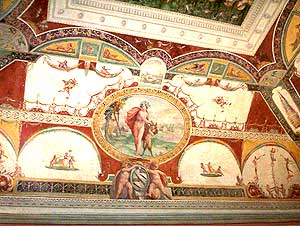
I found myself falling easily into the gracious language of Italy that calls for a sense of largesse and thankfulness in a world of ancient art and architecture, modern gourmet food, sweeping vistas, and some of the world’s best wines.
The Umbria region, which is made up of 92 mostly small Medieval towns, includes the astonishing art and artifacts of Assisi, the rich art and culture of Spoleto, the Grotto in Perugia that is host to musical events such as the International Female Rock Festival, and Narni with its “DaVinci Code” style secrets.
While famous religious art was a prevalent theme during my stay, the Umbria region holds a treasure trove for both nature/recreation and history buffs as well as those who wish to relax and enjoy amazing food and wine.
Did I say amazing food and wine? Even the olive oil is something special here. And not to worry if you are a vegetarian. In this beautiful agricultural region, not only is there plenty of produce and grains, but all of the restaurants we visited were more than happy to accommodate with delightful non-meat selections.
Many varieties of truffles are included in a surprising variety of dishes in many of the more upscale restaurants.
Important craft products in the region include ceramics and fine textiles.
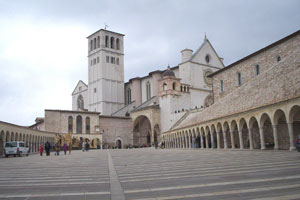
You can also find a great deal of pre-Olympic history throughout the Umbria region with numerous museums, castles, 5,000 year-old villages where people still live, and information about earlier cultures and religions.
Travel and Hotels
You’re going to need a good chunk of time to enjoy the Umbria region, but in a week you can certainly hit the highlights and go home with treasured memories.
Don’t expect your trip to be inexpensive, but with careful research of hotels, campsites if you want to go that route, and the very brave decision to rent your own car for the duration, you can whittle the costs to fit a moderate budget.
For example, flights from New York City to Milan run an average of about $600 round-trip, non-stop, and the flight from Milan to Perugia, to place yourself within striking distance of many interesting destinations, will cost approximately $500 – despite being a much shorter trip of about 45 minutes.
Another option, for those far heartier than I would be to fly directly to Rome, rent a car and drive the three to four hours to Umbria, possibly staying in small towns or campsites along the way and making a circuitous route eventually back to Rome to fly home.

Map reading skills, an understanding international road signage, and a willingness to take on driving as an extreme sport are required.
Hotel prices are not unlike U.S. prices, and in fact are often far lower for much higher quality. In Perugia, you can find a simple single room for $44 with a full breakfast at the Hotel Sant’erlono, with a double room going for about $65 per night also with a full breakfast. There are also many lovely places to stay in the middle of that range.
Or, if you are treating yourself and/or your family, you can stay at the five-star Hotel Brufani Palace at about $160 per night. The Hotel Brufani is in the heart of Perugia, across the street from the Grotto, close to shops, dining, and museums.
The rooms are more than ample, well-appointed, and include many amenities as well as a pool area built grotto-style, with a glass floor showing off historic artifacts of the Etruscans, a local ancient civilization. Italians, with the exception of many of their streets and alleys, do nothing in a small way.
An excellent, modern with old world touches style hotel that had surprisingly modest prices per night (about $70), was the Hotel Vannucci in Citta della Pieve.
If you do wish to camp, one of the best resources is Touring Club Italiano, Corso Italia 10, 20122 Milan; telephone, 011-39-02-85621. They will be happy to send you free information on camping throughout Italy. Fees tend to be very nominal to camp.
Small But Helpful Tips
Bring an alarm clock of some kind. For reasons I never discovered, Umbrian hotels did not seem to have any sort of clock in them and there are times you don’t want to rely on a wake-up call. Speaking of time, Italy is 6 hours ahead of the U.S. east coast.
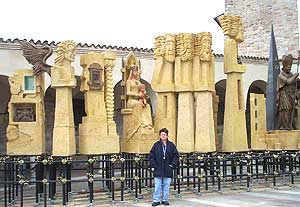
If you travel in spring, pack for both warm and cold weather. Weather can and will wildly fluctuate and can be extremely windy on the colder days.
Assisi
As you approach the Basilica of Assisi, the grandeur of the city named for the kindest, simplest of saints cannot fail to move you. One of the first things you will see besides a magnificent vista is a recently installed series of statues and carvings depicting many world religions from Christian to native Polynesian.
Assisi is one of the most visited towns in the region, with miles of cobbled streets lined with 12th century history and shops featuring chocolates, ceramics, cheeses, wines, and herbs as well as plenty of religious souvenirs.
The basilica is filled with 12th and 13th century frescos as well as artifacts from the time of St. Francis, who was canonized two years after his death October 3, 1226. The endless artwork throughout the basilica was awe-inspiring, but for me, not more so than seeing the actual robe St. Francis wore. Keep in mind if you visit religious sites, wearing shorts and sleeveless tops will often prevent you from entering.
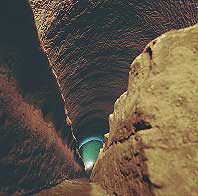
One of the best restaurants I visited nearby was Redibis, where you can dine for a reasonable price (for what is typically a six course meal) in a recently restored 2,000 year-old grotto. For wine and dinner you will spend about $60 to $75 per person. The food is outstanding and the mix of Old World style with clean modern touches lent an incredibly comfortable atmosphere. Telephone 0742-360-130.
Orvieto
Besides what began to be the usual eye-popping cathedrals and frescos by renowned artists such as Perugino and Signorelli, you can also visit La Badia di Orvieto, where you can enjoy fine wine and lodging that has seen the likes of John Travolta, Brad Pitt, and Richard Gere according to the hotels’ owner Isabella Fiumi. The beautiful grounds of what was a 6th century abbey are filled with the sound of songbirds and the odd twanging sound of the country’s crows that inhabit a centuries-old tower on the property is a restful and exotic stopover.
I can’t write about Orvieto’s Pozzo della Cava without laughing – and not because of the caves filled with antiquities and the 16th century well that drops a stomach-quivering 100 plus feet, but because one of my traveling companions decided the name Pozzo della Cava would make a great nickname.
“It sounds like a great name for a boxer,” said Michael Kiefer of Phoenix, Arizona, who joked endlessly about the self-appointed moniker throughout our visit.
Pozzo della Cava is lovingly cared for by the Sciarra family, who discovered and restored the caves and their artifacts. There is also simple but elegant indoor and outdoor dining connected to the cave’s museum.

Spoleto
This is the town of many festivals for every cultural taste. Unusual among them is the “Race of the Vaporetti”, a folkloric and amusingly reckless race of bob-sled like vehicles (no snow required) which was banned for a period of time and revived in 1948.
The Carnival that takes place each February and March has a history dating back to the first years of the 19th century. It is a fixed date of Umbrian folklore, renewing itself yearly with offerings of allegorical parades, shows, and masquerades that involve the town.
Information on the number of events held throughout the summer that embrace ballet, theater, and many types of music, such as the Festival of Two Worlds can be found by emailing info@iat.spoleto.pg.it or by telephone at 0743-238920.
The local tourist office, located at Piazza della Liberta 7, 06049, Spoleto, will also provide information on horse and mountain bike riding tours as well as a variety of other activities. Their telephone is the same as above.
As with nearly everywhere in Umbria, you will also encounter spectacular views and architectural wonders, most of which date back to medieval times.
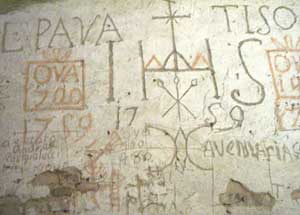
Narni
Narni is an ancient and vibrant city dating back to 299 B.C. Officials from this town quizzed our group about whether Americans might be interested in connections they have been discovering between their town and the famed “Chronicles of Narnia” by C.S. Lewis. The thought was possibly to develop a tour that would focus on the literary and magical aspects of the popular stories.
However, we were able to tour what I found to be one of the more impressive sites in Umbria – Narni Underground. Led by archeologist Roberto Nini, who discovered the 12th century Benedictine chapel underground when he was a teenager and grew up working on his labor of love since 1976, we wandered from room to room amazed by frescos, open burials, (ok, I got a little creeped out here), and a cell covered with the graffiti of a 16th-century Freemason, jailed by the Vatican.
Nini was ecstatic to report that he had just returned from the Vatican library where he confirmed the identity of the prisoner, Giuseppe Andrea Lombardini, who had covered his cell with a multitude of symbolic pictures and was later exiled. The work at this site is ongoing and open to the public and includes a large church aboveground with excavated burials above the underground chapel.
In their excavations they even came upon a mastodon tusk which is displayed in the upper church.
Nini, who began digging at the site with a few friends as a boy, was tipped off by an 80-year-old gardener who told him, “I have a hunch there is a treasure behind that wall.”

Terni
For me, Terni’s highlight was the Marmore Waterfall, a rare Roman design mistake in 271 B.C. that resulted in far too much water being released from the Nera River. After generations of feuding about the water and several modifications made over time, it was eventually redesigned to allow water to flow in an intense waterfall only two hours a day.
The area around Marmore Waterfall is an extraordinary location for nature study, hiking, photography, fly-fishing, and white water rafting.
The water is also a source of electrical power in the area. In December and January the area is restricted due to climactic an environmental reasons. For information call 39 0744362231 or online at italia.it.
For more information on the Umbria region contact The Italian Tourist Board, 630 Fifth Avenue – Suite 1565, New York, New York, 10111, or telephone 212-245-5618.
 Cris Carl is a journalist who currently writes for the Daily Hampshire Gazette. She resides in Greenfield, Massachusetts.
Cris Carl is a journalist who currently writes for the Daily Hampshire Gazette. She resides in Greenfield, Massachusetts.
- These 9 U.S. National Parks Require Reservations in 2024 - April 17, 2024
- Take a Hike in Olympic National Park - April 17, 2024
- The Wild Mississippi: 2340 Miles Across Ten States - April 8, 2024





